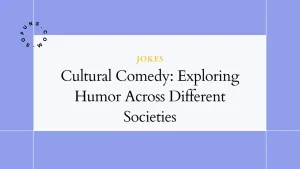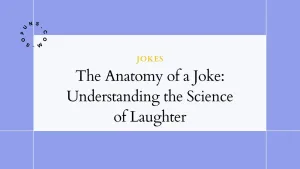Dark comedy, sometimes referred to as black comedy or gallows humor, has a long and controversial history. While often criticized for its shocking nature, dark humor serves many purposes, from helping people cope with trauma to providing social commentary. Those who employ it must tread carefully to avoid causing unnecessary offense. However, when used thoughtfully, dark comedy can be a powerful artistic and psychological tool.
The Allure and Boundaries of Dark Humor
The dark comedy derives its appeal from subverting expectations. Laughing at taboo topics provides a release from societal constraints. According to psychologist Dr. Andrea Dindinger, “Dark humor gives people a way to push back against those norms and constraints by making light of something that’s usually taken very seriously.”
At the same time, finding humor in the touchy subject matter can easily cross lines. Topics like death, disease, violence, and oppression require delicate handling. What one person finds funny, another may consider appallingly insensitive. As such, dark comedy inhabits a grey area between artistic expression and poor taste.
Comedians must carefully assess their motivations and target audience when using provocative humor. Well-executed dark comedy punches up at those in power rather than punching down at disenfranchised groups. It should make people think differently about important issues without trivializing human suffering. Discerning the difference requires nuance and empathy.
The Psychology Behind the Appeal of Dark Humor
Psychological research reveals several theories behind dark comedy’s allure and why it makes people uncomfortable. Incongruity theory states that humor arises from violated expectations. Dark jokes juxtapose disturbing concepts with levity, creating cognitive dissonance.
According to Freudian theory, dark comedy allows people to express repressed fears and desires related to taboo subjects. Laughing releases pent-up psychic tension. Dark humor also provides an indirect outlet for aggression toward societal norms.
Additionally, gallows humor serves as a coping mechanism. Making light of trauma gives people cognitive distance to process difficult emotions. Dark comedy helps build resilience when dealing with horror and injustice.
However, laughter is inherently ambiguous. Audiences may misinterpret ironic intent and take dark jokes at face value, reinforcing harmful stereotypes. The distress provoked can undermine humor’s benefits. Thus, dark comedy must be handled responsibly.
Controversial Topics Addressed in Dark Comedy
Dark humor turns provocative themes into comedic fodder. Death is a staple subject, from gory slapstick to wry observations about mortality. Illness also appears though cancer jokes tend to generate particular controversy.
Race, gender, sexuality, and religion provide frequent dark comedy fodder as well. Edgy comedians argue that addressing stereotypes exposes rather than promotes prejudice. However, such material often perpetuates the very biases it aims to critique.

Violence lends itself to dark humor, though excessive brutality, especially toward disempowered groups, alienates audiences. Similarly, sexual violence and pedophilia rarely come across as funny rather than disturbing.
Political and historical atrocities also inspire dark comedy, especially among oppressed peoples. While satirizing oppressors can provide catharsis, some maintain that genocide and terrorism should be off-limits.
Ultimately, no subject is too solemn for dark comedy. But skillful execution determines whether provocative humor enlightens or offends.
Dark Humor in Literature, Film, and Television
Dark comedy enjoys a rich literary tradition. Shakespeare’s tragedies undercut heavy themes with morbid wit, while Mark Twain skewered societal hypocrisy with biting irony. Modern examples include Joseph Heller’s Catch-22, which tackles the absurdity of war, and Chuck Palahniuk’s Fight Club, which satirizes masculinity and consumer culture.
On film, black comedy classics range from Dr. Strangelove’s nuclear annihilation farce to American Psycho’s indictment of 1980s excess. Quentin Tarantino’s violence-laced romps feature plenty of dark humor. Comedies like Heathers and In Bruges blend pitch-black jokes with weighty themes.
Small-screen dark comedy highlights include programs like MASH, Seinfeld, It’s Always Sunny In Philadelphia and South Park. Netflix’s Dead to Me exemplifies seriocomic TV, balancing grief and loss with caustic humor.
Dark comedy also thrives outside the mainstream, in fringe theater, stand-up clubs, and online platforms, where creators often push boundaries.
Using Satire and Social Commentary in Dark Humor
One way dark comedy stays on the right side of good taste is by employing satire and social commentary. Effective satire uses irony and absurd exaggeration to highlight real-world issues. By mocking injustice and cruelty, dark humor can convey poignant truths.
For example, Joseph Heller’s satirical war novel Catch-22 exposes military bureaucracy via fictional stories whose hyperbolic nature underscores war’s insanity. Similarly, the dark comedy film Get Out uses horror tropes to offer incisive metaphors about racism.
Done thoughtfully, dark satire provides catharsis and motivation for social change. Poorly executed, it desensitizes audiences to societal ills. The line between illuminating critique and trivialization depends on context and artistic merit.
Navigating Sensitivities When Employing Dark Comedy
Due to its provocative nature, dark comedy warrants care to avoid unnecessary offense. Assessing your relationship with the audience provides important context. Inside jokes between close friends differ from public performances.
If addressing controversial issues for a general audience, punching up at institutions rather than vulnerable groups reduces potential harm. Revealing hypocrisy and flaws in those with power can effect change. Avoid punching down at oppressed and disenfranchised demographics.
Also, consider your own relationship to the subject matter. Comedians with firsthand experience with trauma have more standing for gallows humor. Avoid flippantly joking about serious issues that don’t affect you personally.
Ultimately, dark comedy should expose the absurdities underpinning real societal problems, not just provoke shocking laughs. Focus on driving home uncomfortable truths rather than on vulgarity for its own sake.
Why Context and Audience Awareness Are Crucial
Dark comedy often sails close to the wind in terms of taste. Whether provocative jokes land well or miss their mark hinges on contextual factors and audience awareness.
Inside jokes between friends may appear appalling if overheard by strangers. Comedians like Lenny Bruce faced obscenity charges for bits that now seem tame. Societal sensitivities evolve over time.
Good dark comedy punches up at oppressive power structures. It forces audiences to confront harsh realities. Inept attempts at edginess punch down at vulnerable groups, often reinforcing rather than questioning prejudices.
A thoughtful comedian understands their relationship with the audience, tailoring material accordingly. Reading the room and adjusting language prevents well-intentioned jokes from backfiring disastrously.
Ultimately, dark humor must balance edginess with empathy. Vulnerable groups deserve protection from mockery, not to have societal ills trivialized. Context, thoughtful framing, and nuance separate enlightening dark comedy from empty provocation.
Dark Humor as a Coping Mechanism for Life’s Challenges
A less discussed but equally important application of dark comedy is as a coping mechanism for processing life’s difficulties. Dark humor helps people gain emotional distance when grappling with distressing experiences.
Those working in high-stress fields like medicine and emergency services regularly employ gallows humor. Finding the absurd in traumatic situations is key to resilience. As author Kurt Vonnegut wrote, “Laughter and tears are both responses to frustration and exhaustion.”
The dark comedy also helps people handle illness, loss, and fears of mortality. Making jokes in the face of death provides a sense of control and allows indirect processing of terrifying concepts.
Additionally, dark humor builds social bonds – sharing discomfort through laughter creates intimacy. However, one must take care not to belittle others’ suffering with flippant jokes.
When used responsibly, dark comedy can transmute life’s tragedies into sources of catharsis and strength. Finding light in the darkness helps us carry on.
Conclusion
Though often controversial, dark humor serves vital functions, from providing social commentary to coping with trauma. It inhabits a grey area where artistic expression risks causing needless offense.
Navigating that line requires nuance, empathy, and awareness of societal inequalities. Done thoughtfully, dark comedy uplifts and empowers. Handled irresponsibly, it punches down at vulnerable groups. However provoking discomfort remains an essential part of artistic expression.
As with any attempt at humor, context is key. Dark comedy reminds us that laughing at life’s cruelties is part of what it means to be human. But avoiding unnecessary harm separates edgy material that enlightens from empty provocation.
Ultimately, dark humor must balance entertainment with inconvenient truths. Laughter makes difficult ideas more palatable but should avoid reinforcing societal problems. Done right, dark comedy makes the darkness bearable.
Frequently Asked Questions About Dark Humor
What are the benefits of dark humor?
Some benefits of dark humor include helping people cope with trauma, providing social commentary, revealing hypocrisy, exposing harsh truths, creating intimacy through shared discomfort, allowing the expression of taboo thoughts, and offering catharsis.
What makes dark humor funny?
Dark humor derives its humor from incongruity – mixing disturbing concepts with lightness violates social expectations. It also allows indirect expression of fears and aggression toward taboos. The tension between the joke’s tone and its content provokes uncomfortable laughter.
Is dark humor morally wrong?
Whether dark humor is morally wrong depends on context and execution. It can punch up to expose societal problems or punch down to belittle oppressed groups. Good dark comedy enlightens, while poorly handled jokes spread harmful stereotypes. Discerning right from wrong requires nuance.
When does dark humor go too far?
Dark humor that promotes prejudice instead of revealing the truth goes too far. Unnecessarily graphic, violent imagery only intended to shock also crosses the line. Comedians should avoid trivializing others’ trauma and reinforce social progress rather than regress.
Does dark humor desensitize people to violence?
Poorly handled dark humor risks normalizing or trivializing violence and tragedy. However, good dark comedy highlights society’s ills to make people care more, not less, about addressing them. Intent, context, and nuance determine whether it desensitizes or enlightens.
Can dark humor be therapeutic?
Yes, dark humor provides therapeutic benefits. Finding absurdity in trauma gives people cognitive and emotional distance to process difficult emotions. It also builds resilience through laughter and helps transform hardships into sources of cathartic humor.






No Comments